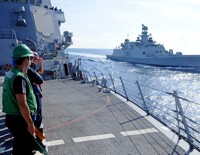During his recent visit to New Delhi, U.S. Defense Secretary Leon Panetta highlighted the evolution of the annual Indo-U.S. naval war game Malabar from a passing exercise for the two navies’ ships into a full-scale engagement across all functional areas of naval warfare. Indeed, the steadily increasing complexity of Indo-U.S. naval force coordination has been a standout feature of an otherwise interest-driven relationship, suggesting Washington increasingly sees India as the western hinge of the U.S. pivot to Asia, with the U.S. Navy backstopping the shift from the Pacific. However, before the Indo-U.S. entente on the seas becomes a full-blown condominium, more dialogue between the two navies will be necessary.
India’s latest naval buildup, unlike a previous one in the mid-1980s, has been welcomed by the existing U.S. alliance framework in Asia at a time when major defense cuts loom in the West and China shows signs of proto-hegemony in its near waters. The degree to which the region is comfortable with the Indian naval expansion is illustrated by former Japanese Premier Shinzo Abe’s endorsement of India’s role in keeping Asian sea lines stable in a way that can reassure Vietnam, the U.S. and South Korea, if not China. India’s stated aim of acting as a net provider of security in the Indian Ocean region has been similarly endorsed by successive Pentagon documents, with the U.S. overtly calling for a greater Indian role in the Indo-Pacific.
This is a far cry from the early days of the Obama administration, when talk of a G-2 arrangement between the U.S. and China angered India. In 2009, a Chinese admiral even talked about dividing up the Indian and Pacific Oceans between the Chinese and American navies. However, rising tensions in the South China Sea have put this narrative to rest. Instead, India and the U.S., along with Japan, Australia and Vietnam, have increasingly converged around the need to maintain freedom of navigation on the high seas. And India is no longer holding back on voicing its support for keeping the South China Sea in particular an open international waterway, as recent comments by the Indian finance minister indicate.

